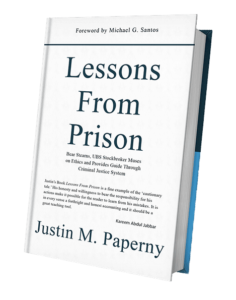If You Don’t Advocate for Yourself, No One Else Will
If you’re heading into sentencing or preparing for prison now is the time to act. Don’t wait. Don’t assume. Build your record, prove your case, and get yourself home as soon as possible.
During our webinar yesterday, I spoke with Jon Gustin, who spent 24 years working for the Bureau of Prisons (BOP), with the last 14 years as the administrator overseeing all halfway houses nationwide. Jon has seen what works and what doesn’t. He understands how the system operates, what case managers look for, and what determines whether someone gets the maximum halfway house time, early home confinement, or gets stuck in prison longer than necessary.
This conversation is about practical steps—what you can do to advocate for yourself, make a solid case, and position yourself for the shortest sentence and earlier release from federal prison.
I will get around to that reentry plan…
A common mistake people make is thinking they have time to figure things out later. They assume their case manager will handle everything, or that a lawyer will sort it out. That’s not how it works. You are your own best advocate.
Jon made it clear: The earlier you start preparing your reentry plan, the better. That means having answers to key questions:
- Where will you live when you’re released?
- How will you support yourself financially?
- What job opportunities have you lined up?
- Have you documented any efforts to better yourself—education, programming, volunteering?
- Are you doing what is required or is it extraordinary?
The earlier you put these pieces in place, the more credibility you’ll have when it’s time for your case manager to make a decision. The people who get the most halfway house time and earliest home confinement are the ones who prove they’re ready for it.
“It’s Too Early” is the Biggest Lie You Can Tell Yourself
Many people assume they have time. They tell themselves, “I’ll start working on my reentry plan later.” But here’s the truth: by the time you think you need it, it’s too late.
Federal prosecutors start building their case early. Judges and probation officers start forming opinions well before sentencing. Your case manager will have dozens—if not hundreds—of people to deal with. If you don’t present a clear, compelling plan, they will default to the easiest option, which is keeping you locked up longer.
Jon emphasized that even if you’re at the very beginning of your case—before you’ve been indicted or sentenced—you should be thinking about sentencing and prison. That means documenting your personal growth, proving you are more than your charges, and planning for reentry now. People who take action early see better outcomes at every stage.
Case Managers Want Documentation, Not Promises: Go Create Your Reentry Plan NOW!
A federal judge once told me, “If it’s not documented, it didn’t happen.” That applies at every stage of the process. Case managers, probation officers, and judges all make decisions based on proof, not just words or as Judge Gorton said, “happy talk!.”
Jon explained that case managers are overworked and often looking for the easiest way to complete their reports. If you provide them with a well-documented reentry plan—including letters from potential employers, a home plan, and evidence of personal growth—they’re far more likely to recommend maximum halfway house time or early home confinement.
If you show up unprepared, expect to be treated like just another case number.
How to Influence Your Case Manager (Without Being a Nuisance)
Not all case managers are the same. Some will be helpful; others will be indifferent. But one thing is true across the board: the easier you make their job, the more likely they are to help you.
Jon explained that case managers have limited halfway house slots. They prioritize people who make their decision easy. If you:
- Provide a clear release plan with supporting documents
- Have a history of good behavior and program participation
- Show progress over time (not just right before release)
…you are far more likely to get the best possible placement.
But if you wait until the last minute, demand extra time, or expect them to “figure it out” for you, don’t be surprised when you get the minimum.
Getting the Most Halfway House Time
Many people don’t realize that halfway house time is not automatic. The maximum standard halfway house placement is 12 months, but few people get that unless they fight for it.
The process works like this:
- Your case manager makes a recommendation.
- The warden approves or denies it.
- The Residential Reentry Manager (RRM) makes the final call.
Jon emphasized that the best way to maximize your time is to start building your case early. You should be advocating for the maximum well before your release date. If you wait until the case manager brings it up, you’re already behind.
The Reality of Home Confinement
Under current rules, if you are not eligible for First Step Act (FSA) credits, the maximum time you can serve on home confinement is 6 months or 10% of your sentence, whichever is less.
If you are FSA-eligible, your earned credits can be applied to home confinement, but this is still subject to approval. Just because you’ve earned the credits doesn’t mean you automatically get home confinement.
This is why Jon emphasized proving your case. If you:
- Avoid disciplinary infractions
- Show consistent progress and program participation
- Have a solid home plan with employment lined up
…you are far more likely to be approved.
Common Halfway House and Home Confinement Pitfalls
Many people make mistakes that cost them extra time in prison. Here are some common pitfalls Jon pointed out:
1. Assuming Your Job Will Be Approved
Not every job is accepted. Case managers and halfway house staff often reject self-employment or jobs that are too similar to the crime of conviction. Always have a backup plan.
2. Ignoring the Small Rules
Halfway houses are strict. Being late, missing curfew, or making an unauthorized stop can get you violated. The smallest mistake can send you back to prison.
3. Not Communicating With Employers
Halfway houses will call your employer to verify your job. If your employer doesn’t answer or isn’t prepared for the call, you could lose the job before you even start.
4. Waiting Until the Last Minute
Your case manager won’t chase you down to give you extra halfway house time. If you don’t advocate for yourself, you’ll get whatever is easiest for them.
Final Thoughts: Start Preparing Now
Jon’s message was clear: If you don’t push for what you’ve earned, you’ll be stuck with whatever the system decides for you. And that’s never the best option.
If you’re in the early stages of a case, start documenting everything. Build your reentry plan. Think about the judge, the probation officer, and your case manager. What do you want them to see?
If you’re already in prison, take charge of your time. Build a record of growth. Stay out of trouble. Advocate for yourself the right way—by presenting a clear plan, not making demands.
The system isn’t designed to help you. It’s designed to manage you. The people who do best are the ones who create, document their progress, and prove why they have earned more leniency.
The question is: Will that be you?
Justin Paperny




